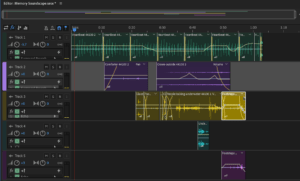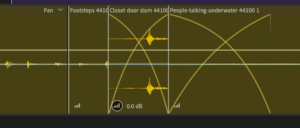Concept :
The concept for mine and Emma’s visual metaphor is a representation of the facade presented by the idea of the “American Dream.” We ultimately decided to use the found footage of the “ideal” 1950’s American families, essentially the epitome of how the idea of the “American Dream” came to be, following WWII. This idea of the “American Dream” although advertised to be something attainable for all, still fell victim to the flawed executive, judicial, and legislative systems of the American government making it something only plausible for white Americans. The metaphor comes into play through the alternation between the protest footage and these clips of what the “American Dream” looked like as a representation of the reality of the struggles black people in America have faced to obtain some facet of the so called American Dream. Not only that but also the metaphor for the facade that this idea of the American Dream puts up when in reality it is all part of a deeply flawed system built off prejudice and racism that the BLM protests aimed to tear down in order for them to be rebuilt.
Process:
- We decided to create our own audio on audition from a combination of clips from the song This is America by Childish Gambino, videos from the protests, speeches from the protests, and a small clip from a Martin Luther King Jr speech. After sorting through lots of youtube videos we downloaded the clips and separated the audio. After that, Emma was the one that made the initial edit of the audio clip and after that we bounced ideas off each other for tweaks we could make.
- After finalizing the version of the audio we were going to use, we made a google drive folder where we put all of the protest clips as well as various different found footage clips both emma and pulled from youtube and trimmed down to the specific parts we felt best represented the metaphor we were trying to convey.
- The thing I probably struggled with the most was having to format videos that were in various different sizes and orientations into one specific frame size without losing the integrity of the clips themselves.
Conclusion:
If I had more time to complete the project I would’ve taken more time to dive deeper looking for found footage to use. I also would’ve liked to have used professional equipment to shoot the protest footage so it seemed more coherent but that wouldn’t have been possible unless there had been a completely perfect situation in which I had used a camera during the actual protests.
At presentation day:
The main feedback I received was that the vertical display of my video made it feel more modern and maybe slightly less professional than a landscape formatted video would have. Despite this, I think having done the project over I would’ve kept it vertical because of the concept itself. The BLM movement is something that started a little bit less than a decade ago and is continuously changing, now a days the format in which we receive news is through social media videos, posts, tweets, etc. all of which are often formatted vertically so I felt it appropriate to have it vertical in order to fit the theme better.




 any part of my memory in order to fit the parameters of the project. After lots of testing out different things, I figured out that for a lot of my sound clips the reverb with different impulses worked quite well to demonstrate what I was envisioning. I also found out whilst editing that I could make anchors along the volum
any part of my memory in order to fit the parameters of the project. After lots of testing out different things, I figured out that for a lot of my sound clips the reverb with different impulses worked quite well to demonstrate what I was envisioning. I also found out whilst editing that I could make anchors along the volum e line of clips and adjust the volume levels in that way instead of just through fading in and out, this allowed me to be more precise in specific areas, which added an extra layer of smoothness between sounds. T
e line of clips and adjust the volume levels in that way instead of just through fading in and out, this allowed me to be more precise in specific areas, which added an extra layer of smoothness between sounds. T he one part I struggled a bit with was the meshing together of two clips in trying to make them sound like one recording although they were two separate clips. I ended up figuring out how to make them sound the most similar by using echo and making the transition between the two much longer than I had previously done for other clips and it ended up sounding quite smooth.
he one part I struggled a bit with was the meshing together of two clips in trying to make them sound like one recording although they were two separate clips. I ended up figuring out how to make them sound the most similar by using echo and making the transition between the two much longer than I had previously done for other clips and it ended up sounding quite smooth. For the diptych project I went through various concepts, finally landing on an idea hoping to convey a social/political commentary on society’s misknowings of their own government or lack of involvement in politics, specifically pertaining to the younger generations in America. I chose this concept because it is an issue I feel very passionate about and I think it is something that needs to be addressed in order to work towards fixing the many issues plaguing American society, the most prevalent among those being ignorance.
For the diptych project I went through various concepts, finally landing on an idea hoping to convey a social/political commentary on society’s misknowings of their own government or lack of involvement in politics, specifically pertaining to the younger generations in America. I chose this concept because it is an issue I feel very passionate about and I think it is something that needs to be addressed in order to work towards fixing the many issues plaguing American society, the most prevalent among those being ignorance. 
